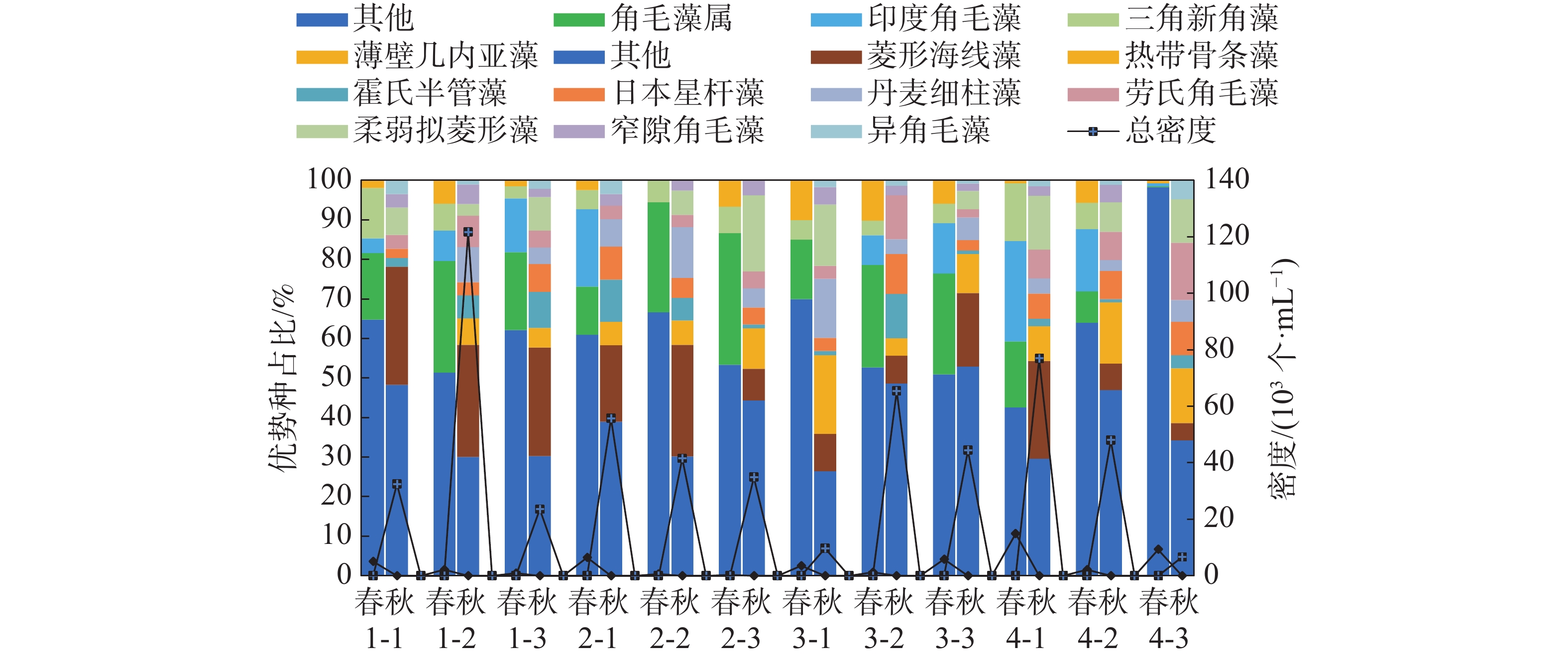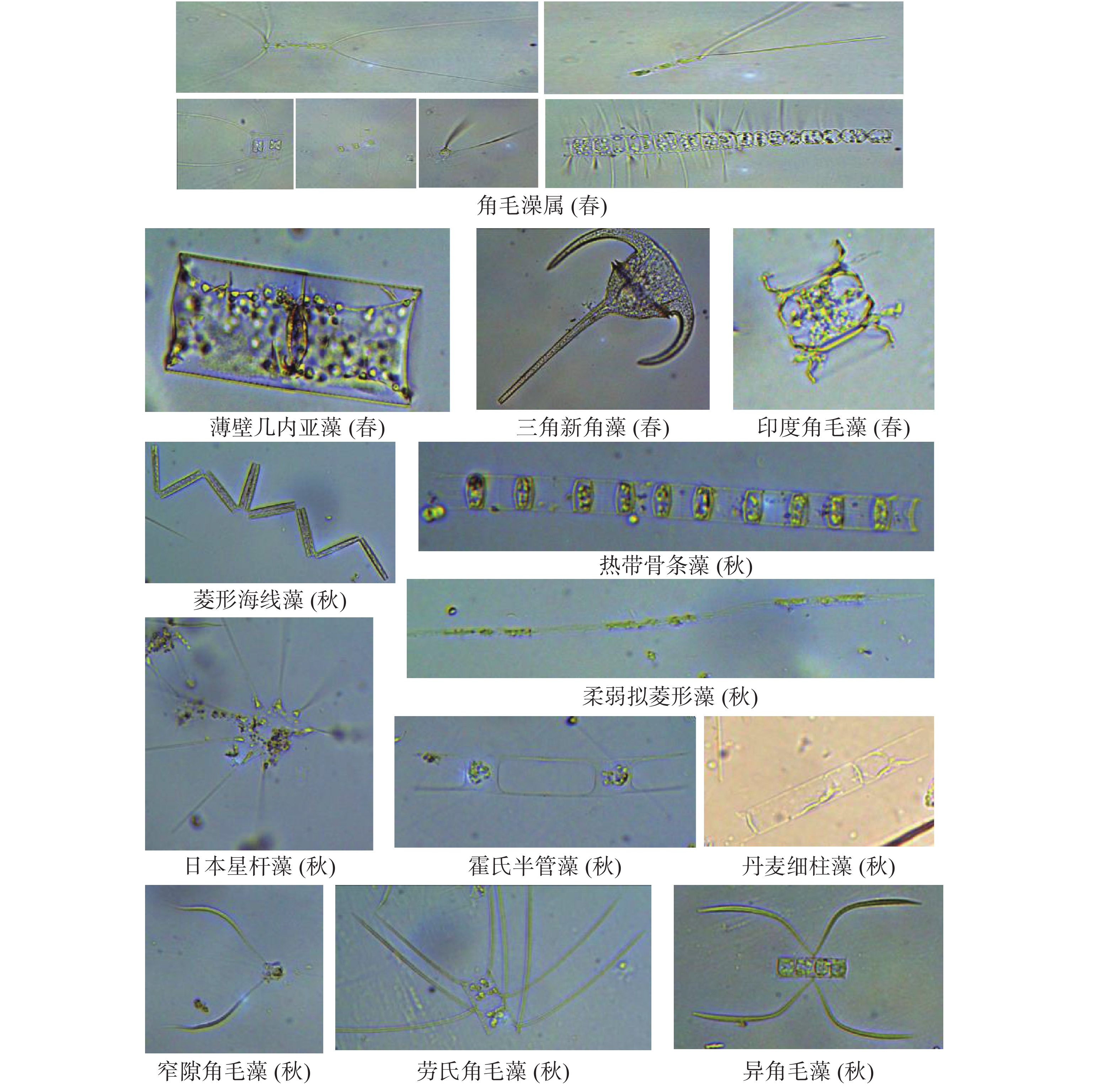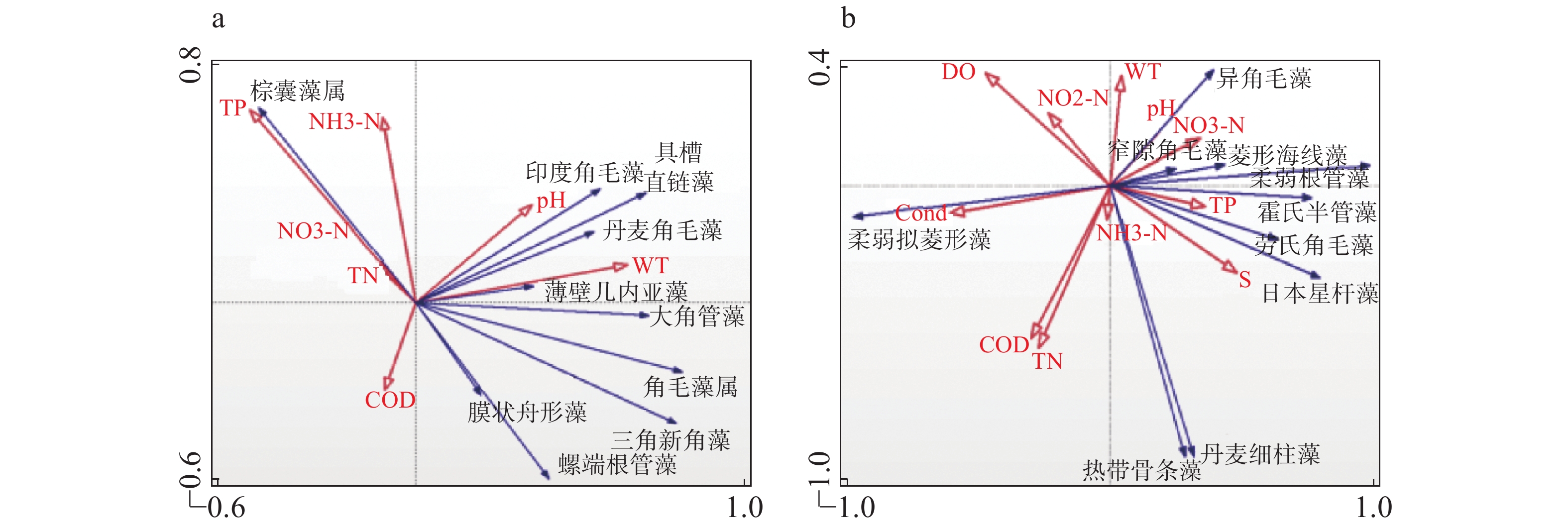-
海洋是地球上最广阔的水体,在生态环境的演变和人类社会文明进程中都发挥着很重要的作用,其中海洋近海岸的生态环境与人类生产活动关系最密切[1-2]。旅游业、航运、海湾建设和水产养殖业等产业在带来经济发展的同时,对近海岸的生态系统也产生了显著的影响,如导致海水水体不同程度的污染、海洋垃圾增多、水质下降、富营养化、生物多样性下降等[3],这一现象已经引起了国内外学者的广泛关注。浮游植物是海洋生态系统中的一个重要的组成部分,也是海洋食物链中最基础的一个环节[4],其作为海洋中有机质的重要来源,对海洋生态系统中的物质循环和能量流动都发挥着不可代替的作用[5]。据报道,浮游植物的群落结构组成对海洋生态系统影响巨大,海洋生态系统的变化也会反过来影响浮游植物的群落结构[6-7]。因此,研究浮游植物的群落结构变化对了解海洋生态系统的变化极具重要性。三亚湾(18°13′~18°17′N;109°22′~109°29′E)位于海南省三亚市南部沿海,是一片绵延22 km的海滩旅游胜地,该海域分布着东玳瑁洲和西玳瑁洲。由于近年来旅游业的发展,人类的频繁活动对该海域产生了或多或少的影响。笔者根据2019年夏(4月份)、秋(9月份)两季对三亚湾海域网采浮游植物和水样调查,对三亚湾的浮游植物种类组成、海洋藻类物种多样性以及海水水质进行了分析,旨在为三亚湾旅游胜地环境保护和海洋近海岸生态系统保护提供参考。
HTML
-
2019年4月和9月,参考《海洋调查规范》(GB12763.9—2007),在三亚湾海域设置12个调查站位(图1),地理坐标见表1,依据GB12763.6—2007《海洋监测规范》规定,对三亚湾浮游植物进行网采、贮存、运输和预处理。浅水区域使用浅水Ⅲ型浮游生物网(网长140 cm,网口内径37 cm,网口面积0.1 m2)进行网采,距底层2 m的位置开始往上垂直拖网3次采集样品。水深超过50 m的调查站位,由50 m至表层垂直拖网3次采集样品,现场测定气温、水温、水深、盐度、透明度、溶解氧、pH值和电导率。取1 L网采样品用终浓度为2%的甲醛固定后带回实验室备用,剩余样品随后静置沉淀浓缩至50 mL,取0.1 mL浓缩样品在LEICADM6000B生物显微镜下进行种类鉴定和计数。
站位 Station 经度 Longitude 纬度 Latitude 站位 Station 经度 Longitude 纬度 Latitude SYW1-1 109°29′62.64″ 18°15′25.60″ SYW3-1 109°25′40.17″ 18°17′16.29″ SYW 1-2 109°28′64.52″ 18°14′40.02″ SYW3-2 109°25′02.31″ 18°16′24.50″ SYW 1-3 109°27′40.35″ 18°13′51.32″ SYW3-3 109°24′53.51″ 18°15′40.60″ SYW 2-1 109°27′95.60″ 18°16′62.48″ SYW4-1 109°23′41.00″ 18°17′26.04″ SYW 2-2 109°27′13.76″ 18°15′38.84″ SYW4-2 109°22′48.61″ 18°16′05.49″ SYW 2-3 109°26′19.22″ 18°14′66.95″ SYW4-3 109°22′29.77″ 18°15′07.20″ Table 1. Geographical locations of the survey stations in Sanya Bay
-
取0.1 mL浓缩样品在生物显微镜下计数、鉴定。Shannon-Wiener多样性指数(H′)、Pielou均匀度指数(J′)、Margalef丰富度指数(D)和优势种确定(优势度Y)的计算公式[8-11]如下:
式中:H′为多样性指数;S为种类数;Pi=ni/N(ni是第i个物种的个体数,N是全部物种的个体数);fi为第i种在各个站位出现的频率,Pi为第i种占各个站位细胞总量的比例。
1.1. 站位设置和采样方法
1.2. 样品处理及分析
-
调查期间三亚湾春季平均水温26.5 ℃,秋季平均水温28.87 ℃。调查水域春秋两季pH值均为8.28。春季盐度平均为31,秋季盐度高达35.31。春季电导率为20.53~20.87 μs·cm−1,平均值为20.75 μs·cm−1。秋季电导率有所增高,平均值达到24.31 μs·cm−1。春季溶解氧为8.97~10.5 mg·L−1,平均值为9.88 mg·L−1,明显高于秋季,秋季的平均值5.65 mg·L−1(表2)。
站位 Station 水温
Seawater temperaturepH 电导率
Conductivity盐度
Salinity溶解氧 DO/(g·L−1)
Dissolved oxygen春 秋 春 秋 春 秋 春 秋 春 秋 SYW1-1 26.47 29.60 8.29 8.30 20.67 25.00 31 34 8.97 6.09 SYW1-2 26.50 29.30 8.28 8.30 20.73 25.00 31 36 8.97 5.65 SYW1-3 26.47 28.80 8.29 8.30 20.70 25.00 31 35 9.00 5.72 SYW2-1 26.17 29.50 8.28 8.30 20.87 25.00 31 36 9.93 5.39 SYW2-2 26.10 29.40 8.27 8.30 20.80 25.00 31 35 10.40 5.57 SYW2-3 26.10 28.80 8.24 8.20 20.87 25.00 32 35 10.17 5.81 SYW3-1 26.70 28.20 8.27 8.30 20.87 25.00 31 36 10.00 5.82 SYW3-2 26.73 28.40 8.29 8.30 20.80 16.73 31 36 10.03 5.43 SYW3-3 26.43 28.70 8.29 8.30 20.83 25.00 31 34 10.50 5.52 SYW4-1 26.83 28.20 8.26 8.30 20.83 25.00 31 36 10.13 5.37 SYW4-2 26.43 28.80 8.28 8.20 20.47 25.00 31 35 10.20 5.27 SYW4-3 26.43 28.70 8.27 8.30 20.53 25.00 30 34 10.23 6.10 平均值 Mean 26.45 28.87 8.28 8.28 20.75 24.31 31 35 9.88 5.65 Table 2. Environmental parameters of survey stations in Sanya Bay in 2019
-
三亚湾调查海域春季鉴定出浮游植物6门82种,秋季鉴定出4门85种。其中,春、秋季硅藻门分别占浮游植物总种类数的67.07%和78.82%,占据优势类群。春季鉴定出甲藻门22种,秋季16种;春秋两季均鉴定出蓝藻门1种和金藻门1种。除此之外,春季还鉴定出定鞭藻门2种。秋季各调查站位鉴定的浮游植物种类均比春季多(图2)。
-
三亚湾春季浮游植物细胞平均密度为5.13×103个·m−3;秋季浮游植物细胞平均密度为99.8×103个·m−3。秋季平均细胞密度是春季的20倍左右(表3)。除春季站位4-3以定鞭藻门为优势类群,其余站位均以硅藻门为优势种类。春秋两季硅藻细胞密度均明显高于其他藻类,春季占细胞总密度的78.31%,明显低于秋季(96.08%),但春季甲藻细胞密度明显高于秋季(图3)。
站位 Station 浮游植物密度占比/% 密度/(103个·m−3) 硅藻门 甲藻门 蓝藻门 金藻门 黄藻门 定鞭藻门 春 秋 春 秋 春 秋 春 秋 春 春 春 秋 SYW1-1 74.16 100 25.84 0 0 0 0 0 0 0 5.08 32.5 SYW1-2 80.58 98.47 19.42 0.77 0 0.77 0 0 0 0 2.25 12.17 SYW1-3 87.88 95.07 12.12 4.23 0 4.23 0 0 0 0 0.96 23.6 SYW2-1 87.8 98.66 9.76 0.67 0 0.67 2.44 0 0 0 6.53 557.6 SYW2-2 88.89 96.92 11.11 3.08 0 3.08 0 0 0 0 0.64 41.6 SYW2-3 93.33 95.19 6.67 2.14 0 2.14 0 0 0 0 0.31 34.9 SYW3-1 95 97.79 5 0.55 0 0.55 0 0.55 0 0 3.54 90.1 SYW3-2 88.89 94.26 11.11 2.36 0 2.36 0 0 0 0 10.03 65.5 SYW3-3 90.2 95.16 9.8 2.96 0 2.96 0 0 0 0 5.8 44.4 SYW4-1 77.33 98.54 22.67 0.49 0 0.49 0 0 0 0 14.93 76.9 SYW4-2 70.79 90.51 17.98 6.72 1.12 6.72 0 0 1.12 8.99 2.11 48 SYW4-3 4.89 92.34 0 3.28 0 3.28 0 0 9.36 94.89 9.36 60.6 平均值 Mean 78.31 96.08 12.64 2.27 0.09 1.61 0.2 0.05 0.09 8.66 5.13 99.8 Table 3. Phytoplankton density at each station
-
优势度决定优势种,将优势度≥0.02的浮游植物种类作为该海域的优势种类。春季调查期间三亚湾浮游植物优势种共4种,分别为角毛藻属(Chaetoceros sp.)、印度角毛藻(Chaetoceros indicus)、三角新角藻(Neoceratium tripos)和薄壁几内亚藻(Guinardia flaccida)。角毛藻属(Chaetoceros sp.)为第一优势种,优势度为0.163,平均密度为0.84×103个·m−3(表4),在SYW3-2号站位密度最大;印度角毛藻为第二优势种,优势度为0.091,平均密度为0.62×103个·m−3,在SYW4-1号站位密度最大(图4)。秋季调查期间该海域浮游植物优势种共9种,分别为菱形海线藻(Thalassionema nitzschioides)、热带骨条藻(Skeletonema tropicum)、霍氏半管藻(Hemiaulus hauckii)、日本星杆藻(Asterionella japonica)、丹麦细柱藻(Leptocylindrus danicus)、劳氏角毛藻(Chaetoceros lorenzianus)、柔弱拟菱形藻(Pseudo-nitzschia delicatissima)、窄隙角毛藻(Chaetoceros affinis)和异角毛藻(Chaetoceros diversus)。菱形海线藻为第一优势种,优势度为0.184,平均密度为18.3×103个·m−3(表4),在2-1号站位密度最大;热带骨条藻为第二优势种,优势度为0.074,平均密度为80.0×103个·m−3,在2-1号站位密度最大(表4,图4),优势种显微镜下放大400倍的生物学特征见图5。
季节
Season优势种
Dominant species平均密度/(103个·m−3)
Mean density占总密度比例/%
Over total density出现频率/%
Frequency优势度
Dominance春 Spring 角毛藻属(Chaetoceros sp.) 0.84 16.32 100 0.163 印度角毛藻(Chaetoceros indicus) 0.62 12.1 75 0.091 三角新角藻(Neoceratium tripos) 0.36 7.1 91.67 0.065 薄壁几内亚藻(Guinardia flaccida) 0.2 3.93 91.67 0.036 秋 Autumn 菱形海线藻(Thalassionema nitzschioides) 1.83 18.35 100 0.184 热带骨条藻(Skeletonema tropicum) 0.8 8.02 91.67 0.074 霍氏半管藻(Hemiaulus hauckii) 0.71 7.1 100 0.071 日本星杆藻(Asterionella japonica) 0.67 6.72 100 0.067 丹麦细柱藻(Leptocylindrus danicus) 0.7 6.99 91.67 0.064 劳氏角毛藻(Chaetoceros lorenzianus) 0.52 5.21 100 0.052 柔弱拟菱形藻(Pseudo-nitzschia delicatissima) 0.45 4.49 83.33 0.037 窄隙角毛藻(Chaetoceros affinis) 0.31 3.07 91.67 0.028 异角毛藻(Chaetoceros diversus) 0.25 2.48 83.33 0.021 Table 4. Dominant species of phytoplankton in Sanya Bay in 2019
-
浮游植物多样性指数是反映其种类的多寡和各个种类数量差异的函数关系,均匀度则反映其种类数量的分布情况,可以作为生态监测的参数。计算结果表明,春季三亚湾浮游植物的多样性指数和均匀度平均值分别为3.33和0.80,秋季多样性指数和均匀度分别为4.05和0.79。秋季调查时,所有站位的多样性指数均大于3,表明三亚湾海域生境环境优良。春季丰富度指数在0.98~4.18之间,平均为2.26。秋季丰富度指数在2.13~5.41之间,平均为3.715(表5)。
站位 Station 多样性指数 Diversity index 均匀度指数 Evenness index 丰富度指数 Richness index 春 秋 春 秋 春 秋 SYW1-1 3.57 3.76 0.89 0.81 1.76 2.58 SYW1-2 3.54 3.89 0.78 0.74 2.85 3.58 SYW1-3 3.55 3.94 0.84 0.80 2.62 3.23 SYW2-1 3.74 3.66 0.91 0.72 1.82 2.64 SYW2-2 3.19 3.74 0.92 0.79 1.55 2.73 SYW2-3 2.68 4.24 0.89 0.84 1.22 3.42 SYW3-1 2.98 3.57 0.94 0.79 0.98 2.13 SYW3-2 3.92 4.08 0.83 0.78 2.71 3.60 SYW3-3 4.03 4.69 0.83 0.82 3.23 5.41 SYW4-1 3.75 4.00 0.77 0.78 2.91 3.35 SYW4-2 4.50 4.69 0.89 0.85 4.18 4.55 SYW4-3 0.55 4.32 0.15 0.81 1.31 3.93 Table 5. Diversity, evenness and richness of phytoplankton in Sanya Bay in 2019
-
三亚湾海域12个站点水体的总氮、硝态氮、亚硝态氮、氨氮、总磷、COD测定结果(图6)显示,三亚湾春季总氮含量平均值为4.35 mg·L−1,低于秋季的6.45 mg·L−1。春秋两季硝酸盐氮含量平均值分别为0.83 mg·L−1和0.89 mg·L−1,差异不大。春秋两季亚硝酸盐氮含量平均值均为0.008 mg·L−1。秋季氨氮含量平均值为1.91 mg·L−1,高于春季的平均值(0.53 mg·L−1)。春秋两季总磷含量平均值分别为2.09 mg·L−1和0.80 mg·L−1,秋季含量明显下降。春秋两季COD平均值分别为2.81 mg·L−1和5.02 mg·L−1,秋季的含量高于春季的。
-
根据采样调查数据,利用Canoco 5软件对浮游植物群落和环境因子关系进行对应分析。选择出浮游植物丰度前10的物种,首先对数据矩阵进行降趋势对应分析(DCA),根据分析结果中排序轴数值大小特征,判断下一步分析方法。分析结果表明,春秋两季数据采用冗余分析(RDA)较合适。通过蒙特卡洛方法对春秋两季浮游植物群落与环境因子RDA对应关系分析结果。基于三亚湾浮游植物丰度前10的藻株进行相关分析(图7),浮游植物物种主要分布在第一和第四象限,春季总磷、氨氮、水温和pH对浮游植物群落结构影响较大,其中棕囊藻属与总磷和氨氮呈正相关关系,优势藻种中的印度角毛藻、具槽直链藻、丹麦角毛藻和薄壁几内亚藻与水温和pH 2个环境因子呈正相关关系。大角管藻、角毛藻属、三角新角藻、螺端根管藻和膜状舟形藻与总磷、氨氮、硝态氮呈负相关关系。秋季影响浮游植物最大的因素COD、电导率、溶解氧和盐度,水温次之;在水质方面,总氮、总磷和硝态氮影响最大。柔弱拟菱形藻与电导率、COD和总氮呈正相关,与pH、水温、硝态氮和总磷呈负相关;异角毛澡、窄隙角毛澡、菱形海链藻和柔弱根管藻与pH、水温和硝态氮正相关,与COD、电导率和总氮呈负相关;霍氏半根藻、劳氏角毛藻、日本星杆藻、丹麦细柱藻和热带骨条藻与总磷和盐度呈正相关,与溶解氧和亚硝态氮呈负相关。
2.1. 三亚湾调查海域环境参数
2.2. 三亚湾各调查站位浮游植物种类组成
2.3. 三亚湾各调查站位浮游植物密度分布
2.4. 三亚湾各调查站位浮游植物优势种
2.5. 多样性指数、均匀度与丰富度指数
2.6. 各调查站位水质分析
2.7. 浮游植物群落与环境因子RDA对应关系分析
-
三亚湾春秋两个航次调查结果显示,春季共鉴定出浮游植物6门82种,秋季共鉴定出浮游植物4门85种,共发现167种浮游植物,其中春秋两季不同种共145种,共有22种相同浮游植物种类。春秋两季浮游植物种类均以硅藻为主,甲藻次之,与历年三亚湾浮游植物调查研究的结果一致[12]。同时,杨志浩等的研究发现,三亚湾浮游植物硅藻不仅在种类数上占优势,其细胞密度上也同样占据优势,各季节的浮游植物均以硅藻为优势种,本研究的调查结果显示,春秋两季均以硅藻为优势种,硅藻细胞密度占优势,与之相一致[13]。定鞭藻门仅在春季出现,秋季各站位浮游植物种类高多于春季。春季藻细胞平均密度为5.13×103个·m−3;秋季藻细胞平均密度为99.8×103个·m−3。秋季藻细胞密度是春季的20倍左右。
春季调查期间三亚湾浮游植物优势种共4种,分别为角毛藻属、印度角毛藻、三角新角藻和薄壁几内亚藻。其中角毛藻属为第一优势种。春季三亚湾受外海水温度影响较大[14-15],因此,一些外海广温性种则占据优势。角毛藻属于广温性种,是近岸海域常见的赤潮藻种[16]。温度盐度是影响角毛藻分布的主要因素[17],角毛藻的大量生长是水体富营养化的指征之一[18]。秋季优势种共9种,分别为菱形海线藻、热带骨条藻、霍氏半管藻、日本星杆藻、丹麦细柱藻、劳氏角毛藻、柔弱拟菱形藻、窄隙角毛藻和异角毛藻。菱形海线藻为第一优势种。春季三亚湾浮游植物的多样性指数、均匀度和丰富度指数平均值分别为3.33、0.80和2.26,秋季多样性指数、均匀度和丰富度分别为4.05、0.79和3.43。综合多样性指数和均匀度指数来看,三亚湾春秋两季水体环境均为优良等级,浮游植物种类多样性高,且结构稳定[19]。
历年来研究显示,三亚湾主要的影响环境因子包括温度、盐度、气象条件和营养盐含量等[20]。本研究水质调查结果显示,三亚湾总氮、氨氮和COD含量平均值秋季高于春季,总氮、氨氮和COD含量的增高是水体富营养化的特征指标[21],说明秋季浮游植物生境较春季差。海水中COD含量的增高说明了该海域受到有机污染物的污染,COD含量越高污染越严重,COD含量的增多是导致赤潮藻类大量繁殖的因素[22]。说明可能是由于旅游业的开发,而对三亚湾的环境保护措施不足,导致三亚湾的水质受到污染。秋季总磷含量明显下降,硝酸盐氮和亚硝酸盐氮含量两季差异不明显。
RDA分析结果显示,春季影响浮游植物最主要的环境因子是总磷、氨氮、水温和pH,其中,棕囊藻属与总磷和氨氮呈正相关关系,氮磷元素是影响浮游藻类生长的主要元素[23-24]。优势藻种中的印度角毛藻、具槽直链藻、丹麦角毛藻和薄壁几内亚藻与水温和pH2个环境因子呈正相关关系。水温变化会进一步导致水体的物理、化学性质和生物的活动发生改变,以此对浮游植物的组成及分布产生影响[25]。研究报道,在河口浮游植物的调查中发现,pH是影响其分布组成的重要环境因子[26-27]。秋季影响浮游植物最大的因素COD、电导率、溶解氧和盐度,水温次之。盐度的变化主要是影响浮游植物的渗透压,进而对浮游植物的群落组成产生影响[28]。在水质方面,总氮、总磷和硝态氮影响最大。柔弱拟菱形藻与电导率、COD和总氮呈正相关,与pH、水温、硝态氮和总磷呈负相关。异角毛藻、窄隙角毛藻、菱形海链藻和柔弱根管藻与pH、水温和硝态氮正相关,与COD、电导率和总氮呈负相关;霍氏半根藻、劳氏角毛藻、日本星杆藻、丹麦细柱藻和热带骨条藻与总磷和盐度呈正相关,与溶解氧和亚硝态氮呈负相关。
总体来说,三亚湾海水中的氮磷营养盐、pH、盐度、COD和海水的温度是影响该海域浮游藻类的主要因素。三亚湾浮游藻类多样性调查发现,该海域浮游植物生存环境优良,但存在个别赤潮藻种。三亚湾属于旅游开放区,应降低旅游业对三亚湾水体的影响以及减少当地生活污水的排入,保护海域水体环境。





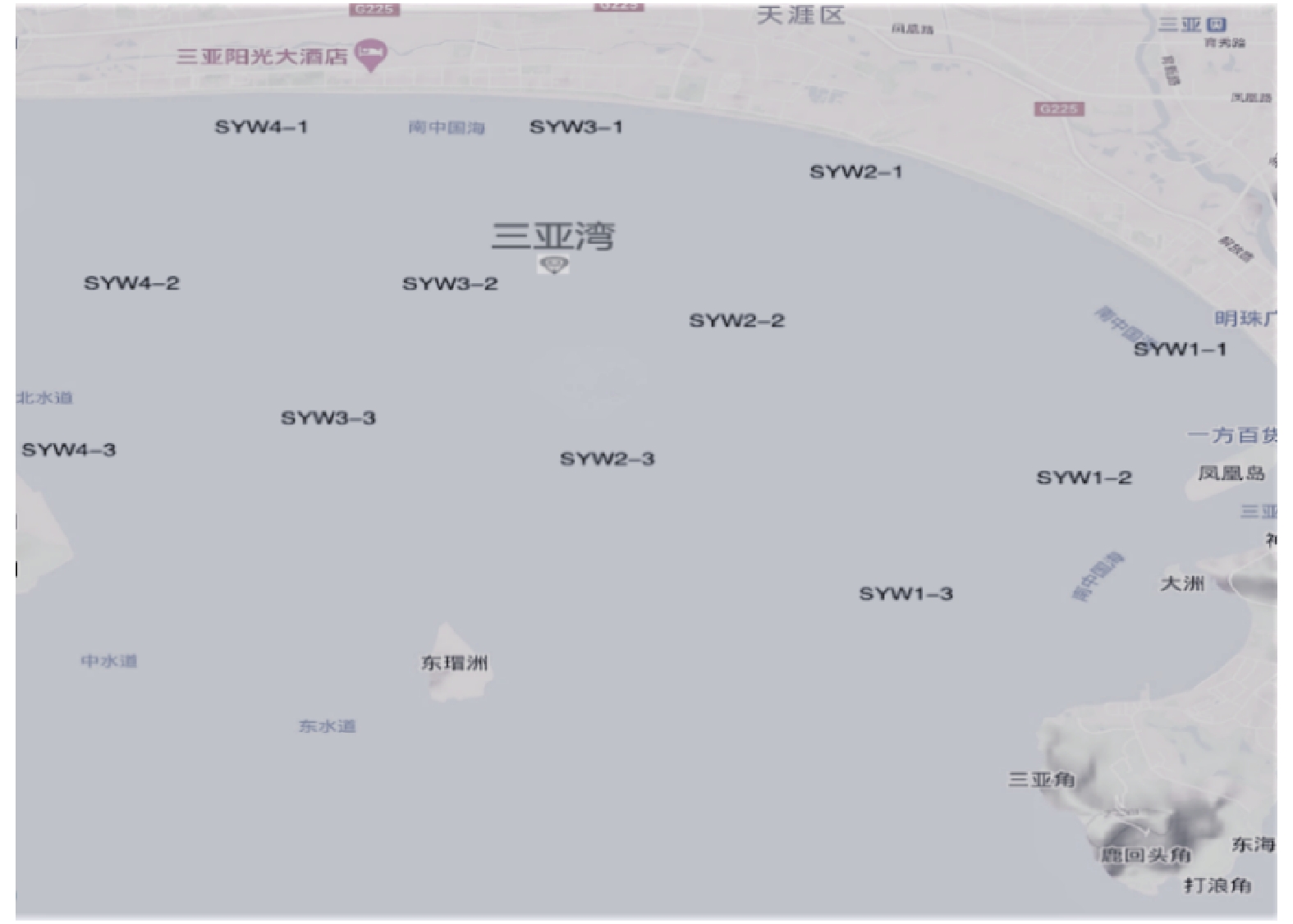

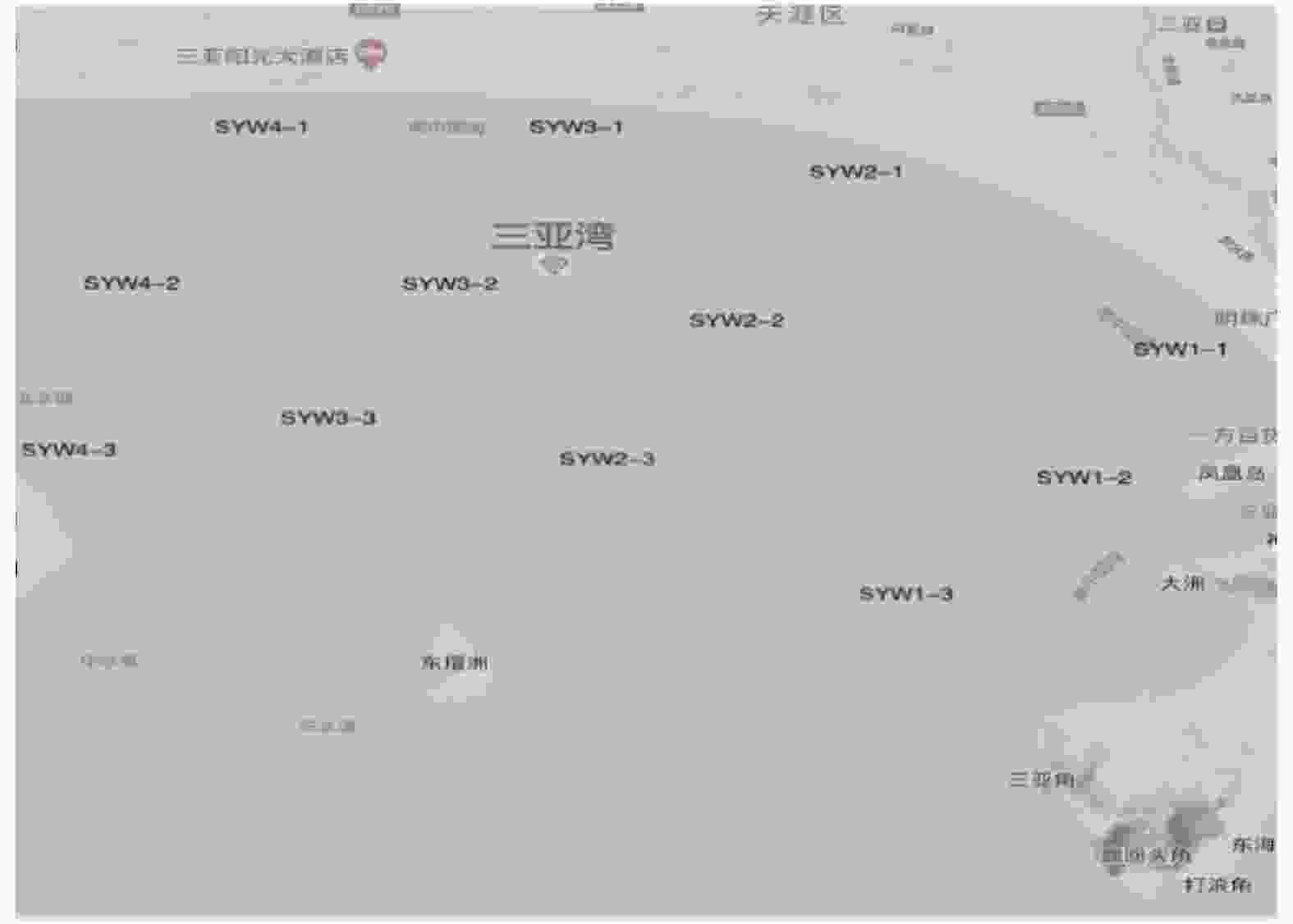


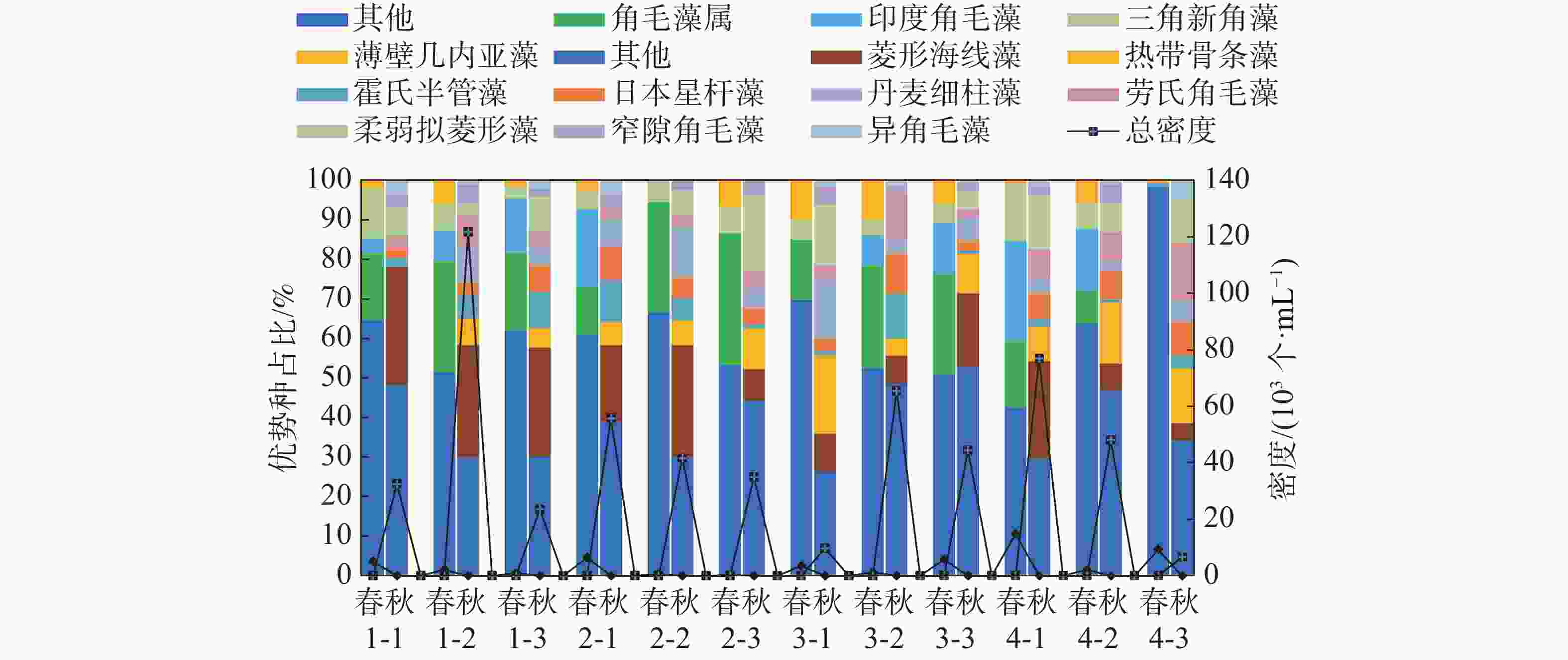


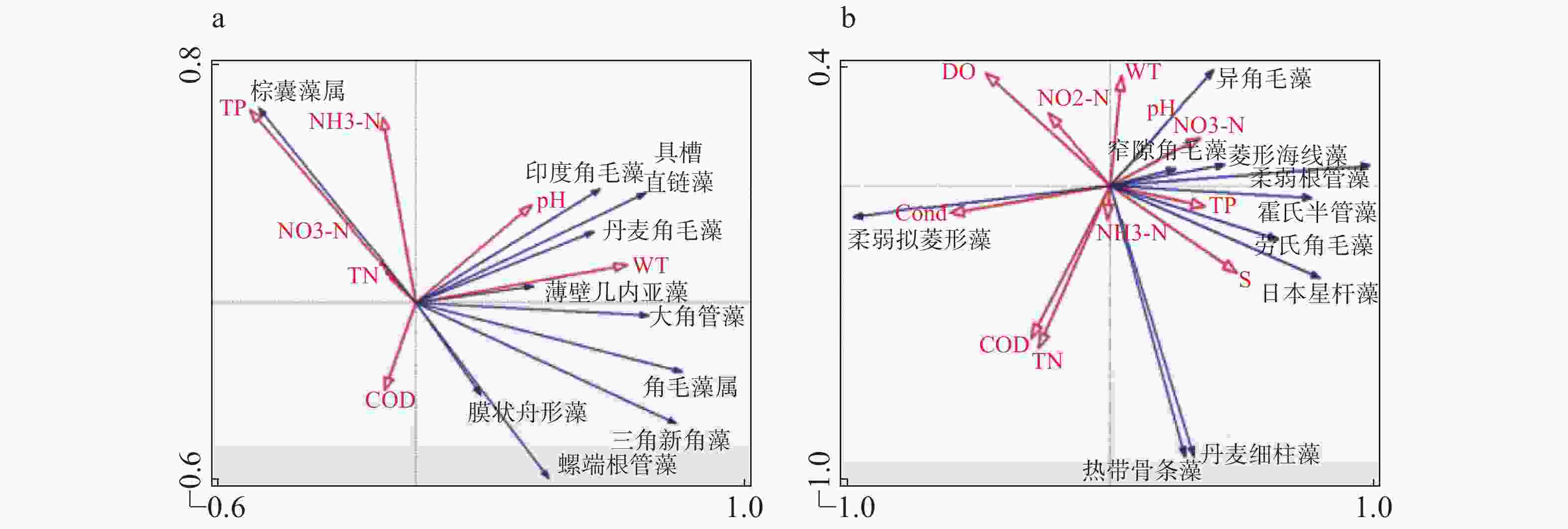
 DownLoad:
DownLoad:


